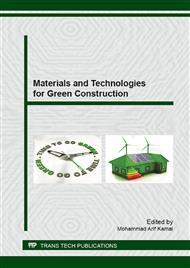[1]
H.M. Künzel 2010, Hygrothermal behaviour and simulation in buildings (chapter in Materials for energy efficiency and thermal comfort in buildings, Hall, 2010).
DOI: 10.1533/9781845699277.1.54
Google Scholar
[2]
M.R. Hall, (edited by) Materials for energy efficiency and thermal comfort in buildings. Woodhead publishing limited, Oxford, (2010).
Google Scholar
[3]
Z. Pavlík, E. Vejmelková, L. Fiala., R. Černý 2009, Effect of moisture on thermal conductivity of lime-based composites, Int. J. Thermophysic, Vol. 30, 1999–(2014).
DOI: 10.1007/s10765-009-0650-y
Google Scholar
[4]
H. M Künzel, Simultaneous heat and moisture transport in building components. Dissertation. University of Stuttgart, Stuttgart, (1995).
Google Scholar
[5]
UNI EN ISO 15148, 2003, Hygrothermal performance of building materials and products - Determination of water absorption coefficient by partial immersion.
DOI: 10.3403/02801954u
Google Scholar
[6]
M. R Hall M., D. Allison, a), Analysis of the hygrothermal functional properties of stabilised rammed earth materials. Building and Environment, Vol. 44, pp.1935-1942, (2009).
DOI: 10.1016/j.buildenv.2009.01.007
Google Scholar
[7]
K. Kießl, Kapillarer und dampfforminger Feuchtetransport in mehrschichtigen Bauteilen – Rechnerische Erfassung und bauphysikaliske Anwendung. Dissertation, University of Essen, (1983).
Google Scholar
[8]
X. Aimin X., Vapour Sorption Theories. Seminarieuppgift till doktorandk. urs Transportprocesser i Byggnadsmaterial, Chalmers University of Technology, Goteborg, Sweden, (1991).
Google Scholar
[9]
NORDTEST Report, Moisture Buffering of Building Materials, Nordic Innovation Centre, (2005).
Google Scholar
[10]
T. Padfield, The role of absorbent building materials in moderating changes of relative humidity. PhD Thesis. The Technical University of Denmark, Department of Structural Engineering and Materials, (1999).
Google Scholar
[11]
C. Rode, K. Grau, Moisture buffering and its consequence in whole building hygrothermal modelling. Journal of Building Physics. Vol. 31, pp.333-360, (2008).
DOI: 10.1177/1744259108088960
Google Scholar
[12]
L. Pel, Moisture transport in porous building materials, Ph.D. thesis, Eindhoven University of Technology, the Netherlands, (1995).
Google Scholar


